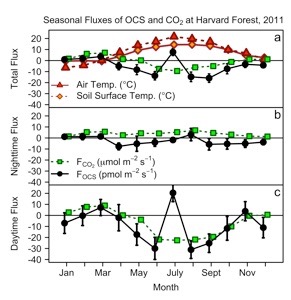Seasonal fluxes of carbonyl sulfide in a mid-latitude forest
November 2015
PAPER:
R. Commane, L. K. Meredith, I. T. Baker, J. A. Berry, J. W. Munger, S. Montzka, P. Templer, S. Juice, M. S. Zahniser and S. C. Wofsy: Seasonal fluxes of carbonyl sulfide in a mid-latitude forest, Proceedings of the National Academy of Science, 112, 46, 14162-14167, doi:10.1073/pnas.1504131112, 2015 link pdf
DATA:
Commane, R, Wofsy, S. 2014. Fluxes of Carbonyl sulfide at Harvard Forest EMS Tower since 2010. Harvard Forest Data Archive: HF2014
Carbonyl sulfide (OCS) is the most abundant sulfur gas in the atmosphere. It has a minimum in the summer associated with uptake by vegetation and soils, which is closely correlated with CO2. The flux of OCS provides a quantitative independent measure of the activity of the biosphere, especially how open the stomata of the leaves are to the air (stomatal conductance) and how much carbon they take up.
We describe the factors controlling the hourly, daily, and seasonal fluxes of OCS based one year of observations at a forest in Western Massachusetts, USA in 2011. Vegetation dominated the uptake of OCS, with daytime fluxes accounting for 72% of the overall uptake for the year. The night-time fluxes were driven by both soil uptake and incompletely closed stomata.
Net OCS emission was observed at times of high temperatures in summer. We still do not understand the mechanism driving this emission but some emission was also seen during the fall/autumn senescence period. The diurnal (daily) and seasonal variations show a variable relationship with CO2, and means that OCS cannot be used as a direct tracer of photosynthetic activity. However, it is a good tracer for ecosystem activity, specifically stomatal conductance.
The instrument used in this research was developed while I was working at Aerodyne Research with Mark Zahniser. We further developed an already existing quantum cascade laser spectroscopy (QCLS) instrument for high frequency continuous measurements of carbonyl sulfide (OCS) at a precision of ~3pptv (1s) (from Commane et al., 2013 pdf). Further development of the instrument during the deployment lead to the production of the OCS mini-QCLS, which is now used by various groups around the world to measure OCS fluxes in a variety of ecosystems and in laboratory experiments.
